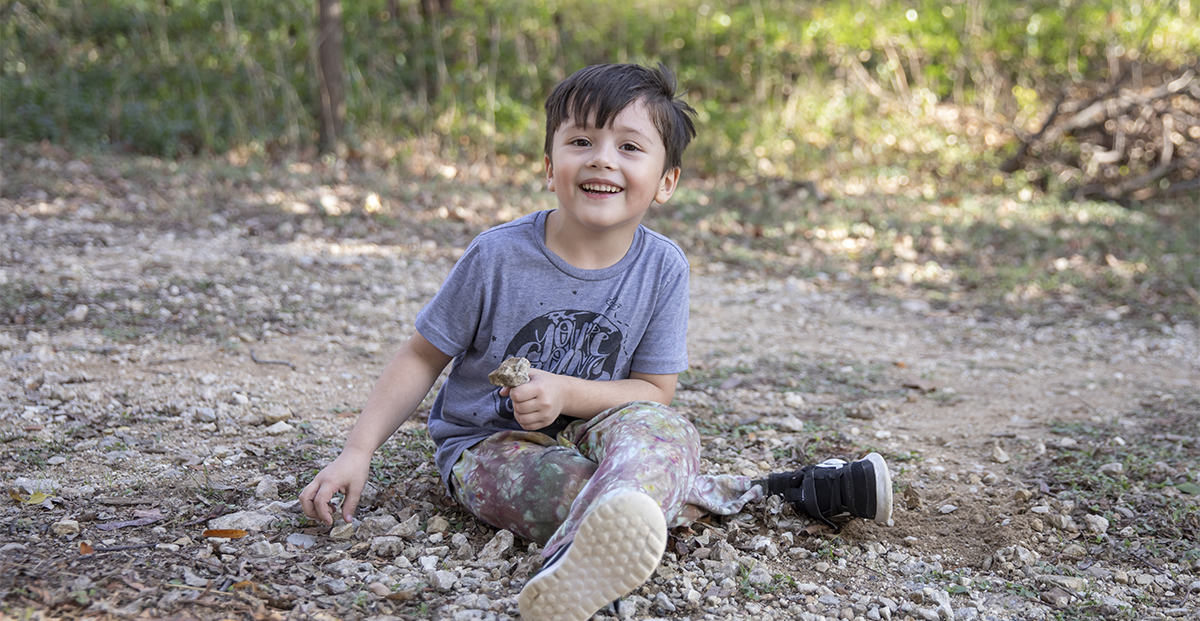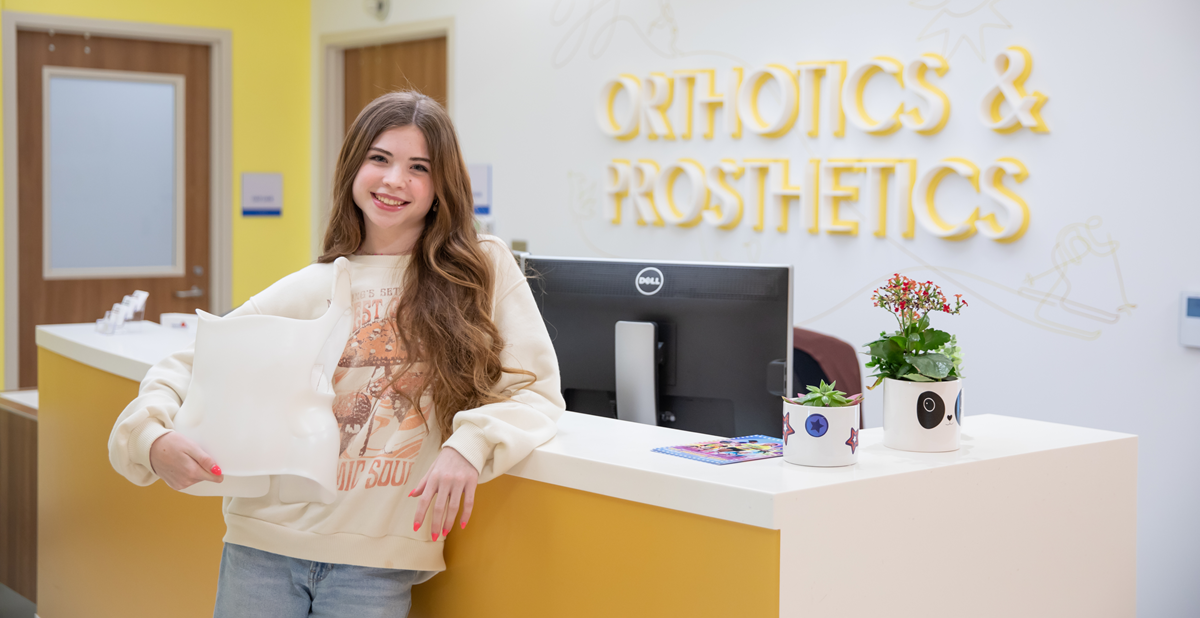
Jun 30, 2022 / Prosthetics & Orthotics
Just like Family: Team Approach to Individualized Treatment Just for Kids
Cover story previously published in Rite Up, 2022 – Issue 1.
by Hayley Hair
The Orthotics and Prosthetics clinic door swings open and a friendly call of “hey, buddy!” rings out from the doorway. From the waiting area, that’s the cue 6-year-old River, of San Antonio, was waiting to hear. He drops what he’s doing, stands up and begins an animated, dramatic performance, a new one each time, while making a beeline straight toward the voice he heard.
During one visit, River decides to be a monkey and raises his arms overhead and lets his hands flop left to right as he takes quick, close steps. Another time, he’s transformed into a monster. River stretches his arms and legs out wide. He hunches his shoulders down and growls while taking giant, exaggerated steps.
Receiving and excitedly mirroring all of this playfulness is Scottish Rite for Children prosthetist Dwight Putnam, who’s been designing, adjusting and perfecting the fit of patients’ prosthetic limbs for 15 years.
River’s mom, Cristine, is also enjoying this production and has her phone out to video this joyful interaction. “It’s so homey coming here,” Cristine says. “We get so excited now because it feels like we get to see family when we come here.”
River’s multidisciplinary team of orthopedic surgeons, psychologists, physical and occupational therapists, nurses, prosthetists and many others have filled River’s visits with calmness, consistency and consideration.
Using names like Uncle Dwight for Putnam and Grandpa Tony, aka J. A. “Tony” Herring, M.D., chief of staff emeritus, for his pediatric orthopedic surgeon, Cristine feels like she has found the perfect place for River’s supersized personality and his growth, both physically and mentally.
River was born with bilateral fibular hemimelia, a condition affecting the bones in both of his lower limbs. When River was 3 months old, the orthopedic team began working to thoroughly inform and educate Cristine about the condition and help her make the best decision to provide a full, active life for her son.
“It is a rare condition, but it is the most common congenital anomaly of the lower limb,” Herring says. “We specialize in that, and we see and treat many kids with this condition.”
When presented with the options of amputating the part of the limb missing bones or possibly going through limb lengthening treatment, Cristine was connected with families for peer support where she could ask questions and engage with a family who had been through these treatments. “The family we spoke to told us that amputation was the best decision they had made for their child and family,” Cristine says. “They were a lot of help, and that made the decision a little bit easier for me.”
“As much clinical information as the family is provided, I honestly think that it’s probably more those peer consultations that explain the amputations so well,” Putnam says. “They are able to see and actually talk to families that have walked that same path.”
Valentine’s Day five years ago, when River was just beginning to pull up to walk, he had the amputation surgery. “It was a very bittersweet day, and I figured it would be a good day that he could always remember,” Cristine says. “It was a hard decision to make, but I think he’s thriving because of this.”
Herring, Putnam and the whole care team at Scottish Rite see what Cristine’s describing all the time. “There’s no place in the world that has a team like ours, or at least not one that I’ve encountered,” Herring says. “It’s just so patient-focused. That’s what Scottish Rite is all about. Everybody is about doing the right thing for these children.”
That exceptional care continues for River, and the bond between the family and Scottish Rite staff in various departments has continued to strengthen, even through the ups and downs. “The relationship between River and Dwight was not so pretty at the beginning,” Cristine says. “Dwight told me ‘give it time, in a couple of years, I’ll be his best friend.’” Several pairs of prostheses later, what Putnam called “turning a corner” finally happened.
“I still remember his first quiet visit with no tears or screaming,” Putnam says. “River came in and said ‘hey Uncle D, I need new legs,’ and then he climbed up on the bench, rolled over and stuck his legs out in the air for casting.”
Putnam and River now focus on silly TikTok dances and inside jokes. “You become integrated into the family, and a lot of times, you feel like you are a part of the extended family,” Putnam says. “We get to watch these kids grow up, and it gives a family confidence to know that we are totally looking out for their kid.”
What’s on the horizon for River? “It’s fun following them in the clinic,” Herring says. “It’s like they are bringing a bicycle to the bike shop, and they are pointing at their prosthesis saying, ‘this thing’s broken down here, and it’s got to be fixed, but let me show you my blue ribbon for high jumping or my soccer team medal.’ They don’t have any real physical difficulties with it. Once they have prostheses, there’s no stopping them.”
Cristine can’t wait for what’s next for River. “This is the start of seeing what this little boy can do,” Cristine says. “He’s the coolest kid ever, and I have so many dreams for him.”
Uncle Dwight and Grandpa Tony feel that way, too.
Read the full issue.
by Hayley Hair
The Orthotics and Prosthetics clinic door swings open and a friendly call of “hey, buddy!” rings out from the doorway. From the waiting area, that’s the cue 6-year-old River, of San Antonio, was waiting to hear. He drops what he’s doing, stands up and begins an animated, dramatic performance, a new one each time, while making a beeline straight toward the voice he heard.
During one visit, River decides to be a monkey and raises his arms overhead and lets his hands flop left to right as he takes quick, close steps. Another time, he’s transformed into a monster. River stretches his arms and legs out wide. He hunches his shoulders down and growls while taking giant, exaggerated steps.
Receiving and excitedly mirroring all of this playfulness is Scottish Rite for Children prosthetist Dwight Putnam, who’s been designing, adjusting and perfecting the fit of patients’ prosthetic limbs for 15 years.
River’s mom, Cristine, is also enjoying this production and has her phone out to video this joyful interaction. “It’s so homey coming here,” Cristine says. “We get so excited now because it feels like we get to see family when we come here.”
River’s multidisciplinary team of orthopedic surgeons, psychologists, physical and occupational therapists, nurses, prosthetists and many others have filled River’s visits with calmness, consistency and consideration.
Using names like Uncle Dwight for Putnam and Grandpa Tony, aka J. A. “Tony” Herring, M.D., chief of staff emeritus, for his pediatric orthopedic surgeon, Cristine feels like she has found the perfect place for River’s supersized personality and his growth, both physically and mentally.
River was born with bilateral fibular hemimelia, a condition affecting the bones in both of his lower limbs. When River was 3 months old, the orthopedic team began working to thoroughly inform and educate Cristine about the condition and help her make the best decision to provide a full, active life for her son.
“It is a rare condition, but it is the most common congenital anomaly of the lower limb,” Herring says. “We specialize in that, and we see and treat many kids with this condition.”
When presented with the options of amputating the part of the limb missing bones or possibly going through limb lengthening treatment, Cristine was connected with families for peer support where she could ask questions and engage with a family who had been through these treatments. “The family we spoke to told us that amputation was the best decision they had made for their child and family,” Cristine says. “They were a lot of help, and that made the decision a little bit easier for me.”
“As much clinical information as the family is provided, I honestly think that it’s probably more those peer consultations that explain the amputations so well,” Putnam says. “They are able to see and actually talk to families that have walked that same path.”
Valentine’s Day five years ago, when River was just beginning to pull up to walk, he had the amputation surgery. “It was a very bittersweet day, and I figured it would be a good day that he could always remember,” Cristine says. “It was a hard decision to make, but I think he’s thriving because of this.”
Herring, Putnam and the whole care team at Scottish Rite see what Cristine’s describing all the time. “There’s no place in the world that has a team like ours, or at least not one that I’ve encountered,” Herring says. “It’s just so patient-focused. That’s what Scottish Rite is all about. Everybody is about doing the right thing for these children.”
That exceptional care continues for River, and the bond between the family and Scottish Rite staff in various departments has continued to strengthen, even through the ups and downs. “The relationship between River and Dwight was not so pretty at the beginning,” Cristine says. “Dwight told me ‘give it time, in a couple of years, I’ll be his best friend.’” Several pairs of prostheses later, what Putnam called “turning a corner” finally happened.
“I still remember his first quiet visit with no tears or screaming,” Putnam says. “River came in and said ‘hey Uncle D, I need new legs,’ and then he climbed up on the bench, rolled over and stuck his legs out in the air for casting.”
Putnam and River now focus on silly TikTok dances and inside jokes. “You become integrated into the family, and a lot of times, you feel like you are a part of the extended family,” Putnam says. “We get to watch these kids grow up, and it gives a family confidence to know that we are totally looking out for their kid.”
What’s on the horizon for River? “It’s fun following them in the clinic,” Herring says. “It’s like they are bringing a bicycle to the bike shop, and they are pointing at their prosthesis saying, ‘this thing’s broken down here, and it’s got to be fixed, but let me show you my blue ribbon for high jumping or my soccer team medal.’ They don’t have any real physical difficulties with it. Once they have prostheses, there’s no stopping them.”
Cristine can’t wait for what’s next for River. “This is the start of seeing what this little boy can do,” Cristine says. “He’s the coolest kid ever, and I have so many dreams for him.”
Uncle Dwight and Grandpa Tony feel that way, too.
Read the full issue.



